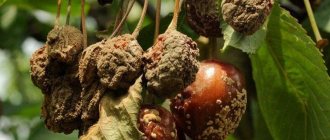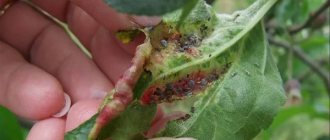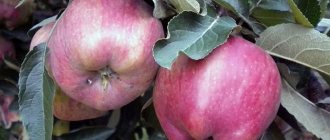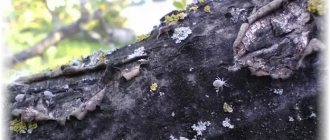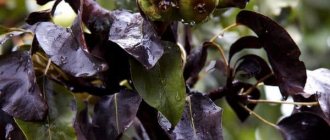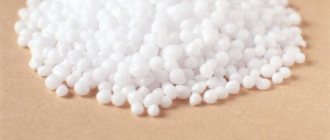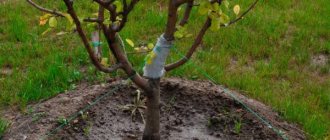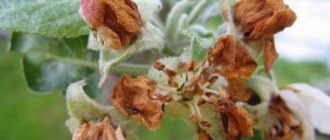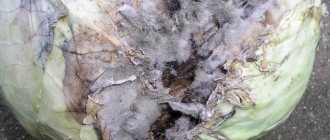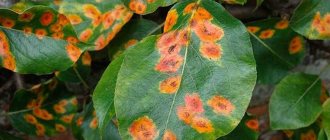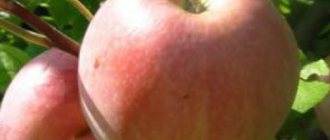Who is the causative agent of the disease
The disease is caused by a ubiquitous fungus. The causative agent monilinia fructigena is ubiquitous. Apple trees growing in temperate and warm climates are equally affected by it. The fungus monilinia fructigena damages apples, pears and stone fruits. The pathogen monilinia mali is highly specialized. It infects only one type of plant; only apple and pear trees are affected. This type of infection is common in the southern regions and gardens of the Far East. The life cycle of the fungus monilinia fructigena consists of 2 stages, and that of monilinia mali - of 3.
Folk remedies to combat moniliosis
If we talk directly about folk remedies, then there are no such methods in the fight against fungi. There are several methods that have been tested by time, but they are more suitable for combating pests that like to live on apple trees. At the same time, they can be used exclusively for preventive treatments, but they are not suitable for treatment and control. Basically, traditional methods are excellent for combating pests such as codling moths and weevils.
Of course, it is impossible to immediately get rid of fruit rot or any other manifestations of moniliosis with one or two treatments. One way or another, the spores will spread throughout the season, somewhere they will manifest themselves more strongly, somewhere less and less frequently. Symptoms can appear at absolutely any time, since the spores take root well even in frost, and they also take root on fruits that have already been collected from the site, so the crop can begin to hurt even during storage. Any spraying and treatment of the area must be carried out immediately, as soon as the very first signs are noticed that something is wrong with the plant, that it is sick or suffers from a lack of immunity. Prevention in general should be carried out regularly, along with regular inspections of the plant for the appearance of any diseases. It is also worth noting that today breeders have not yet developed a variety that will be absolutely resistant to diseases, so it is best to be very attentive to care measures, as well as to some varieties. Most often, summer-ripening apple trees, that is, relatively early varieties, are attacked by fungal spores.
Forms of moniliosis
The disease can occur in different ways. Its symptoms and course depend on the type of fungus that has infected the fruit tree. There are two forms of moniliosis:
- fruit rot;
- monilial burn.
Fruit rot
A tree infected with the fungus monilinia fructigena can be recognized by the symptoms of fruit rot, which appear on young apples:
- at the initial stage these are small spots of brown color;
- the entire surface gradually turns brown;
- The pulp has no taste, its structure becomes spongy;
- Small gray-yellow pads form on the surface of the apples; they create a pattern in the form of circles.
Apples infected with the fungus mummify, turn black, and harden if the weather is cold and dry. In humid, warm summers, most apples are affected by fruit rot in the filling phase and at the ripening stage. Part of the crop dies during storage and transportation.
Monilial burn
The first signs of a monilial burn may appear in the spring. In May, you can see leaves on apple trees that are distinguished by the red color of the leaf blade in the area of the central vein.
The infection affects:
- leaves;
- petioles;
- inflorescences;
- ovaries
When examining the underside of diseased leaves, small white conidial pads may be visible. Infection (monilinia mali) causes drying of the fruiting shoot (leaves, ovary). In mature fruits, monilial burn does not occur.
Why is apple tree moniliosis dangerous?
Monilia infection occurs rapidly. As the fruits ripen, the number of infected apples increases. The fungus makes its way along the stalk to neighboring branches, and in the spring it moves to young ovaries.
The disease poses a threat to humans. Eating infected fruits leads to the development of mycotoxicosis. When the fungus enters the body, internal organs and lymph nodes, skin, nails, hair, cornea, and mucous membrane are affected.
This is already garbage - not a harvest
Stages
The life cycles of the fungus occur during the fruiting period of the apple tree. The fungus monilinia fructigena, which causes fruit rot, is characterized by 2 stages: conidial, sclerotial. The pathogen monilinia mali may also have a rare third stage - marsupial.
See also
Description and characteristics of the Brusnichnoe apple tree variety, what are the subspecies and regions of growthRead
Conidial
At this stage, a mycelium is formed from single-celled colorless conidia in the form of a large number of chains. Conidia spread through raindrops, gusts of wind, and insects.
Fruits whose surface has mechanical damage suffer from infection. They are formed as a result of bad weather or due to insect pests. A larger percentage of apples suffer from fruit rot if the weather is warm and rainy in summer.
Sclerotial
This stage occurs during the period when the apple tree is at rest. The fungus, in the form of mycelium, overwinters in unharvested and fallen apples or in cracks in the bark.
Moniliosis of fruit trees and stone fruits
Apple trees
An apple tree becomes infected during flowering through damaged bark. The incubation period lasts 10 days, but the first signs are visible 5 days after infection. If the trees are treated at this time - before sporulation begins, then there is a chance for a quick recovery.
After the end of the incubation period, the leaves, flowers and ovaries turn brown and dry out. The leaves, unlike other affected parts, do not fall off and look charred. In warm and humid weather, on the underside of the leaves and on the petioles, fungal spores accumulate in white pads.
The fruits are affected by another type of fungus, Monilia. It penetrates into apples through damaged skin. Round brown spots appear on the surface of the fruit. The pulp softens, rots, and the taste deteriorates. Apples wrinkle and turn black.
Pears
The disease spreads rapidly from mid-summer, during fruit ripening, in hot and rainy weather. Flowers and ovaries turn brown and dry out. The foliage also changes color and curls, but remains on the tree and does not fall off for a long time. On the bark of a diseased tree, a mycelium forms in the form of a gray coating.
The fruits become covered with brown spots, on which gray growths appear over time. The pears begin to rot, eventually mummifying and falling off the tree.
Cherries
Infection occurs during flowering. With severe infection, the leaves on the tree quickly change color. At first they show redness, then they turn brown and dry out. Cherry flowers and ovaries are dying. The infection further penetrates the branches and causes them to dry out.
With mild damage, moniliosis can develop in a latent form. The leaves remain green almost all summer and turn brown only towards the end of August. Black dots also appear on them.
Deformed fruits develop from the surviving ovaries. In rainy weather they may crack. The fruits turn brown, and at the end of summer they are covered with light pads of fungal spores. They have an alcoholic taste and an unpleasant odor. Some of the wrinkled and dried fruits fall off, some hang on the branches for a long time.
Plums
On plums, the disease manifests itself in 2 forms: fruit rot and monilial blight of stone fruits.
During flowering, rapid infection of the tree begins. The spores penetrate the plant tissue through the pistils. Leaves, shoots, ovaries, and then fruits and branches are affected. These parts turn brown and dry out. Dead leaves and partial flowers do not fall off. Cracks appear on old branches and gum oozes out.
The emerging fruits are already infected with spores from diseased branches. The infection penetrates through microcracks in the skin due to temperature changes or as a result of mechanical friction.
Gray rot develops on the fruits. Plums on branches quickly deteriorate, become deformed and dry out. Some of them crumble to the ground, the rest hang on the tree. Mushrooms overwinter on damaged branches, in carrion that has not been removed from the ground, and in unfallen fruits. In spring, signs of the disease reappear.
Cherries
The main signs of the disease are brown, half-dried leaves, dark and dry branches in areas of infection, wrinkled fruits, and cracks in the bark. Most often, the infection enters through flowers in the spring. Infection can also occur through the kidneys.
When the mycelium overwinters on a tree for many years, soft areas appear on the shoots. Blackened and dried leaves and branches look burnt against the background of healthy parts of the tree.
How does infection occur?
Spores lead to disease; they penetrate apples and tree tissue through micro- and macrocracks. The main reasons leading to moniliosis of apple trees:
- vital activity of insect pests;
- the presence of infected apples, their contact with healthy fruits;
- other apple tree diseases;
- the variety has low resistance to fungi monilinia mali, monilinia fructigena;
- poor care of fruit trees, lack of preventive measures.
The infection is spread by wind, rain, insects, and dirty garden tools. A long winter with frosts, snowfalls and a protracted spring, which does not bring joy with warm, sunny days, contribute to the appearance of the disease. The fungus enters warehouses along with dirty storage containers.
Varieties prone to disease
Moniliosis spreads to fruit trees. Stone fruits are loved by the fungus Monilia cinerea, while pome fruits are loved by Monilia fructigena. Quince is affected by the pathogen Monilia cydonia.
The following varieties of apple trees resist the disease worse than others:
- Antonovka vulgare;
- Aport;
- Renet Pisgouda;
- Renet of Landsberg;
- Padding;
- Borovinka.
They are recommended for breeding by experienced gardeners who can spot the disease in time.
How to treat if infection occurs
Based on the timing of fruit ripening and the degree of infection of the tree, gardeners determine how best to combat the infection.
Mechanical destruction of affected plants
In autumn, the remaining fruits are removed from the trees. They are disposed of outside the garden plot. The spores do not die if the apples are buried in the ground.
Infected fruits are the main source of infection; they are pecked by birds, eaten by pests (codling moth, weevil), and spores are spread throughout the garden.
All dry shoots are cut out and burned. When removing a diseased branch, up to 10 cm of healthy tree tissue is grabbed. Apple tree trunks are covered with a layer of lime. For greater effect, a fungicide solution is added to it. In the summer, trees are inspected, fungus-affected shoots, ovaries, and fruits are cut out and destroyed.
See also
Description and characteristics of the Ural Nalivnoye apple tree variety, frost resistance and growing characteristicsRead
Chemicals
Chemical agents that have been tested by more than one generation of gardeners, Bordeaux mixture and copper sulfate are relevant in the fight against moniliosis of apple trees. Before the leaves bloom, use a 3% solution, in autumn and summer - 1%. Prevention of the disease is pest control; it is carried out with the help of insecticides: “Aktara”, “Profi”, “Decis”.
Biological drugs
Treatment of apple trees with biological products gives good results. “Pentaphage C” is used if there is little time left before harvesting. This product is safe for humans, so trees and fruits can be sprayed with its solution several days before picking apples.
Harmless to humans and effective against fungus:
- "Fitolavin";
- "Alirin";
- "Fitosporin M".
Use of fungicides
Fungicides contain active substances that kill the fungus and inhibit its reproductive abilities. When treating apple trees for moniliosis, they resort to help:
- "Skora";
- "Horus"
- "Abiga Peak".
Solutions of these drugs are sprayed on all parts of the diseased tree, and the soil around the trunk is treated. Fungicides are used throughout the season. Treatment is carried out once every 2 weeks.
Folk methods of struggle
There are no folk recipes that destroy the fungus. There are proven methods for controlling apple tree pests (codling moth, weevil), they can be used to prevent fungal diseases.
The danger of fruit rot for an apple tree
If moniliosis is not dealt with in a timely manner, the fungus will infect the entire tree. There will be practically no harvest, and those fruits that manage to ripen will be unfit for consumption. Over time, the entire tree will die, in which, due to the active activity of the fungus, all biochemical processes will be disrupted, and therefore it will dry out.
Moniliosis makes it impossible to get a harvest
Important! A tree damaged by the fungus is a source of infection for other garden crops. If it is not eliminated from the site, the entire garden will soon become infected.
Scheme and processing time
The table shows proven treatment schemes against moniliosis.
| A drug | Consumption | Usage time |
| "Hom" | 40 g per bucket of water, 5 liters of solution per 1 apple tree | 1 time in the budding phase, 2 times after flowering |
| "Horus" | 2 g of product per bucket of water | Preventive treatments are carried out throughout the season (once every 2 weeks), for the purpose of treatment at least 2 times, flowering trees are not treated, at least 2 weeks must pass from the date of the last spraying to harvesting the apple trees |
| Bordeaux mixture | Consumption of 1% solution – per 1 m² 200 ml | Treatment is carried out once every 2 weeks |
| "Strobe" | 2 g of product per bucket of water | Trees are treated once every 2 weeks, the last time 30 days before harvesting |
Time to get rid of fruit rot
The speed of eliminating moniliosis from an apple tree depends on the degree of damage to the tree and what drugs are used. On average, 1 to 2 months are enough to heal the plant. But this does not mean that the disease will completely disappear. Therefore, we must not forget about the need for annual seasonal prevention.
Proper agricultural technology and care are the key to a strong and healthy tree
Disease prevention
To prevent moniliosis from developing on trees, it is recommended to treat those varieties that are most susceptible to its formation. This is especially important for plants that have already been exposed to the disease before.
The following steps should be followed:
- application of fertilizing;
- fungicide treatment.
If chemical treatment has been carried out, the fruits can be eaten only after 1 month.
If a tree is highly susceptible to the pathogen and has spread all the way to the trunk, the spores can be completely destroyed only by burning all the branches entirely. This is the only way to prevent the spread of fungus throughout the garden.
